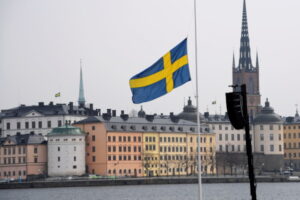This post is part of a series where I examine (which really means “read up on”) the economic and political development of the Scandinavian (or Nordic) nations from the end of WW2 to today, and summarize what I’ve learned into a blog post. Why am I doing this? Because the ongoing debate about “Scandinavian socialism” vs “Scandinavian capitalism” interests me. I’m curious for information devoid of ideological rhetoric. If you found this post via an Internet search, it probably makes sense to start with the first post in this series, the link to which is both above, and here.
Table of Contents
A summary of major economic changes, 1945 to the present
Pre WW2
Like Denmark, Sweden was neutral in WW1 and as such avoided the economic devastation of the war. During the war, Sweden exported to nations involved in the war which interestingly provided both economic growth to Sweden and led to shortages and its accompanying inflation.
Wartime trade barriers within Europe came down after the war, other European nations needed less of what Sweden offered, and Swedish economic shortages turned to surpluses, which in turn led to rapid deflation and decreasing profit margins for Swedish firms.
This drove firms into liquidation, production fell by 25%, and unemployment rose to about 30%. This peaked in 1921-22, after which the Swedish economy started to grow again until the effects of the Great Depression reached Sweden in 1930-31 when the unemployment rate rose to about 25%.
WW2 neutrality
Sweden was also neutral during WW2, which again kept their industrial production and labour force intact and allowed them to ramp up production to help rebuild war-torn Europe.
Immediate post WW2
For Sweden, WW2 was followed by an economic boom, as a result of not having to rebuild their industrial base from scratch. Neither their factories nor their labour force was harmed by the war.
The Marshall plan
Sweden also directly benefitted from the Marshall Plan, from 1948 to 1952.
The United Nations
Sweden was one of the first non-participants of WW2 to join the United Nations, which they did in 1946.
However, Sweden has not been big on joining alliances, and to this day are not a member of NATO.
Sweden did join the European Union in 1995, but never adopted the euro as its currency.
1970s and 1980s economic downturn
Most of what is below are summarized from the paper Financial Crisis and Crisis Management in Sweden. Lessons for Today.
It states “Commercial banking was turned into an almost risk-free business” without providing details as to how. While I’m certain that statement is likely true, it would be helpful to know what regulations or lack thereof allowed this to happen.
It further says that after the Bretton Woods system broke down in the early 1970s, Sweden retained capital controls until the end of the 1980s effectively isolating Sweden financially from the world, which presumably led to a decrease in trade. Additionally, the krona was pegged to the US dollar.
In 1982 Sweden devalued the krona relative to the US dollar.
1985 to 1990 upswing
After financial services were deregulated in 1985, debt grew rapidly, housing prices increased, and inflation decreased, as shown in the charts below.
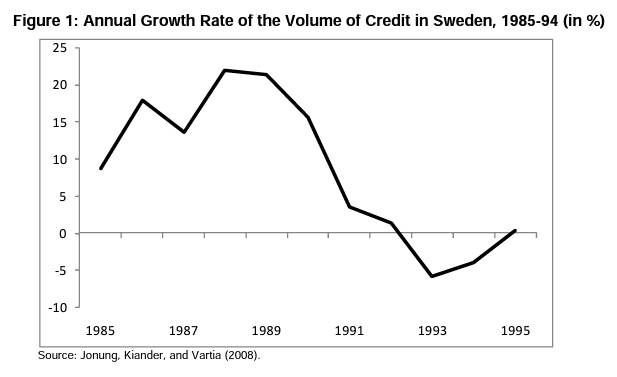
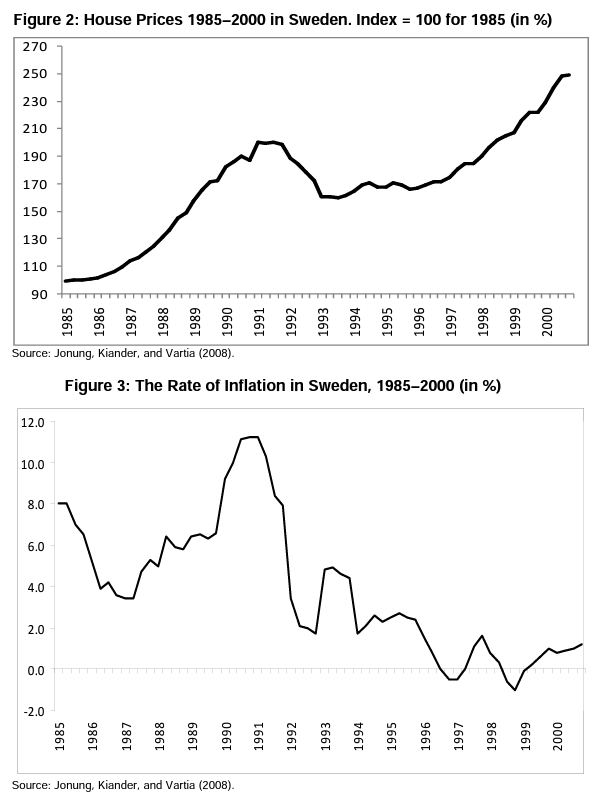
The low, and sometimes negative, interest rates led to increased borrowing for investments (and consumption) which led to asset bubbles in the economy built on debt.
1990 economic downturn
The asset bubbles burst in the early 1990s, ushering in a period of economic decline and increased unemployment.
The paper states this downturn was triggered by an increase in the interest rate in Sweden and it makes this statement shortly after it states that the Swedish government responded to the downturn by implementing austerity (decreased government spending) in October of 1990. As such, the paper may state the cause and effect of this incorrectly.
After the election in 1991, the new government worked to implement supply-side policies to increase the growth potential of the economy.
But since we now have 40 years of evidence that supply-side economics (also known as trickle-down) tends to concentrate wealth and income gains, this may not have had the overall growth effect desired.
1992 recovery
The krona was depreciated in November of 1992 which is credited with starting the recovery. At, or very close to, the same time, a floating exchange rate was introduced for the krona, which is credited with gradually reducing interest rates.
Exports are credited as the major driving force behind the recovery, increasing from 28% of GDP in 1992 to 45% in 2000.
In addition to the depreciation in the value of the krona, the increase in exports is credited to wage moderation and productivity increases.
After 1992, domestic consumption rose more slowly than GDP growth while household savings grew faster than before the crisis.
The importance of institutions
The paper The Rise, Fall and Revival of the Swedish Welfare State: What are the Policy Lessons from Sweden? contains what seems to me to be a rather insightful paragraph.
It’s the first few sentences of section 2.1. And while the statement appears in a paper about the Swedish welfare state, the statement is very generic and not specific to Sweden.
The focus of this paper seems to be the policy mistakes that led to growth stagnation from 1970 to 1992, which starts in section 4. I recommend everyone read this section. It’s really interesting.
The importance of institutions is now more or less mainstream economics, but that was not always the case. Neoclassical growth models predict that growth per person increases when savings and investments increase, but they say nothing about what influences technological development and thereby the long-term growth rate.
The structure of the government of Sweden
Sweden is a parliamentary democracy.
The national legislature is the Riksdag (parliament). It is responsible for enacting laws, amending the constitution, and appointing a government. There are 349 members of the Riksdag.
The monarch has a ceremonial role, and the executive power rests with the prime minister and the cabinet.
The prime minister is proposed by the speaker of the Riksdag, then confirmed by the Riksdag. The prime minister subsequently appoints the ministers who make up the government.
The courts are within the judicial branch.
The political climate
Politics in Sweden has been dominated by one party, the Swedish Social Democratic Party, who have held a plurality, and sometimes a majority, since 1917.
Having said that there are 25 political parties listed on the Wikipedia page devoted to this topic, 8 of which currently hold seats in the Riksdag and/or the European parliament.
At this time, the Swedish Social Democratic Party (mentioned above) holds 100 of the 349 available seats.
I think it’s fair to characterize the Swedish political climate as liberal or left-wing, based on the fact that this party has effectively ruled Sweden now for a little over 100 years and has over that time implemented and expanded a generous social welfare state.
The business sector
The World Bank makes an interesting claim about the availability of credit for Swedish firms. What I find interesting about the claim is their last sentence seems to contradict the sentences that precede it.
Sweden has a healthy financial market: to a large extent Swedish authorities have been successful in creating an environment conducive to private firms’ access to credit. Credit-constrained firms in Sweden tend to spend less on R&D and have lower sales growth than firms that are not credit constrained. The relatively low ranking in the getting credit indicator of the World Bank’s Doing Business indicators does not seem to have affected firms’ access to credit.
Sweden Business Climate – Enterprise Surveys – World Bank Group. (2020). World Bank. https://www.enterprisesurveys.org/en/reports/sweden-report
While Sweden’s per capita GDP is among the highest in the world, so are its taxes.
Swedish exports are about one-third of total GDP, so price stability matters, and for this reason, Sweden pegged their currency (the krona) to the euro.
As with many western nations, the Swedish legislature tasked the central bank with the goal of maintaining price stability by setting and managing to a target interest rate.
Many of Sweden’s largest corporations are large transnational or multinational firms and some employ more people outside Sweden than in Sweden.
Trade unions
Trade union membership in Sweden is high, at 70%, although it has fallen from its peak of 85% in 1993.
In Sweden, the government sets the “boundaries” of employer/employee relations through labour laws, but is not involved in negotiations between employers and organized labour.
There are questions in the Swedish press as to how accepting Amazon (who opened a Swedish platform in the fall of 2020) will be of Swedish labour laws, but so far, the staff at Amazon’s one warehouse in Sweden have a collective bargaining agreement in place with the German subcontractor (Kuehne Nagel) who operate it.
Government corruption
Transparency International, a global organization that ranks public sector corruption, gives Sweden a Corruption Perceptions Index rank of 3, which ranks Sweden as one of the 6th least corrupt nations on earth.
The legal system
The Swedish court system has three types of courts.
The general courts (which includes the district courts) is where cases start. The courts of appeals include the supreme court. The administrative courts handle cases the other courts do not.
There are also special courts for labour disputes and landlord/tenant disputes.
The banking system
Sweden has four different categories of banks: Swedish commercial banks, foreign banks, savings banks, and cooperative banks. Since every type of bank can operate in all areas of banking, it’s not clear to me why this categorization exists.
Having said that, different categories of banks seem to specialize in different services, although they are not required to do so by law.
Banking supervision is the responsibility of the Swedish Financial Supervisory Authority and banks in Sweden are represented by the trade group The Swedish Bankers Associations.
Since 2014, Sweden entered the Foreign Account Tax Compliance Act (FATCA) with the US, so that financial transaction information on “US persons” is provided to the Swedish Tax Agency who in turn provides it to the IRS.
The central bank of Sweden is the Riksbank and their primary objective, given to them by the Swedish legislature, is to set and manage to a target interest rate, which currently is set to 0%.
Sweden, along with Canada, the UK, New Zealand, Australia, and Hong Kong, is one of the nations that has no banking reserve requirement.
Government regulation of the economy
The Heritage Foundation, which ranks countries on their level of economic freedom, seems to contradict themselves as regards Sweden. They rank Sweden as the 9th most economically free nation on earth (out of the 184 countries they rank), while also saying that their very heavy taxation and very high government spending are big drags on the economy.
By all appearances, the Swedish government has never operated in a hands-off laissez-faire way and has always intervened or interfered in the economy.
Like Denmark (and it seems much of Europe), Sweden has a concept of “better regulations” which they describe as:
Sweden has moved from an emphasis on deregulation associated with the market liberalisation of the 1990s to the improvement and simplification of rules (Better Regulation), much on the same pattern as other European countries. The policy has also broadened from simplification and cost reduction to a renewed interest in making ex ante impact assessment work. A key focus throughout has been on the needs of enterprises. Regulatory quality principles have also extended their reach across different institutions, starting with the committees of inquiry which have always been subject to strong requirements (on consultation for example), even if this remains a work in progress regarding the local levels of government.
Better Regulation in Europe: Sweden. (2010).
The above implies the deregulation associated with the market liberalism of the 1990s needed to be abandoned, although I don’t see where they say why.
As you can see if you read through the document linked to above, and from the summary of the economic history of Sweden earlier in this post, Sweden has been a fairly heavily regulated economy at least WW1.
Taxation
Sweden is known for having some of the highest tax rates in the world, but it appears that most residents of Sweden think they get good services in return.
While this article is anecdotal, an American living in Sweden wrote an article on Vox about why he came to embrace the higher taxes in Sweden.
One thing I did not realize prior to doing research for this post is most residents of Sweden pay local income tax, not national. The rate varies between municipalities in the range of 29% to 35%. People who earn above SEK 523,200 (USD $57,443,60) also pay a national income tax of 20%.
The capital gains tax in Sweden is 30%, corporate tax is 20.6%, and there is no inheritance or wealth tax.
Healthcare
While Sweden has a system of universal healthcare, it’s a decentralized system where the central government sets principles and guidelines, and the 290 municipalities and 21 regional councils administer healthcare within their areas. It is fair to say that the system is nationally regulated and locally administered.
Enrollment is automatic, funding comes primarily from regional and municipal level taxes, and grants are provided by the central government.
Education
Under the philosophy that a well-educated population leads to innovation and economic prosperity, Sweden has an education system that is extensive, free for residents, available from age 1 to 18, and mandatory from age 6 to 16.
It is decentralized in as much as, while the central government sets standards, the 21 regional councils determine how those standards are met.
Preschool is from ages 1 to 5, is optional, and is free to parents.
Mandatory school is Kindergarten (age 6), elementary school (grades 1 through 3), middle school (grades 4 through 6), and junior high school (grades 7 through 9).
Senior high school (grades 10 through 12) is available at no cost but is not mandatory.
Sweden has a high degree of school choice. If your child doesn’t like their school, changing schools is easy. The government also pays for private schools, which are called “independent schools”.
There are no tuition fees at either public or private universities in Sweden.
The ratio of pupils to teachers is very low compared to other countries: Preprimary school is 17:1, primary school is 10:1, and secondary school is 9:1.
Natural resources
Sweden’s natural resources consist of copper, gold, hydropower, iron ore, lead, silver, timber, uranium, zinc, timber, and fish.
Arable land is always a natural resource, but in Sweden’s case, only about 10% of Sweden’s landmass is cultivated.
Direct government support and intervention
No one could ever confuse Sweden for a hands-off laissez-faire economy. The government is, at least since WW1, has been heavily involved in economic planning and industrial policy.
It didn’t always go so well, as you can see from the summary of their economic history above which shows various government interventions.
But at no time did the government abandon the welfare state that started prior to WW1, and at no time did the government of Sweden not take an active role in defining the rules for the economy.
The Heritage Foundation ranks nations as to their economic freedom. Per their 2021 index, Sweden is the 21st most economically free nation (out of 169 nations being ranked) on earth, which is one ranking behind the United States.
Foreign direct investment
Sweden has been open to foreign investment for years, although the level of foreign direct investment as a percentage of GDP has been fairly low, except for a large spike in the year 1999. Last year, foreign direct investment was 3.2% of GDP.

Important intra and inter country partnerships
It’s hard to find good quantitative data on important “social partnerships” within a country, but that Sweden has a strong welfare state, tuition-free post-secondary education, and that 68% of Swedish workers are members of trade unions speaks to the importance of the partnership between industry, government, organized labour, and education.
GDP by sector
The most granular data I can find on the GDP of Sweden by sector shows the percentage of GDP from agriculture, industry, and services. As you can see from the chart below, Sweden is predominantly a service-based economy and has been so for since at least 2010.
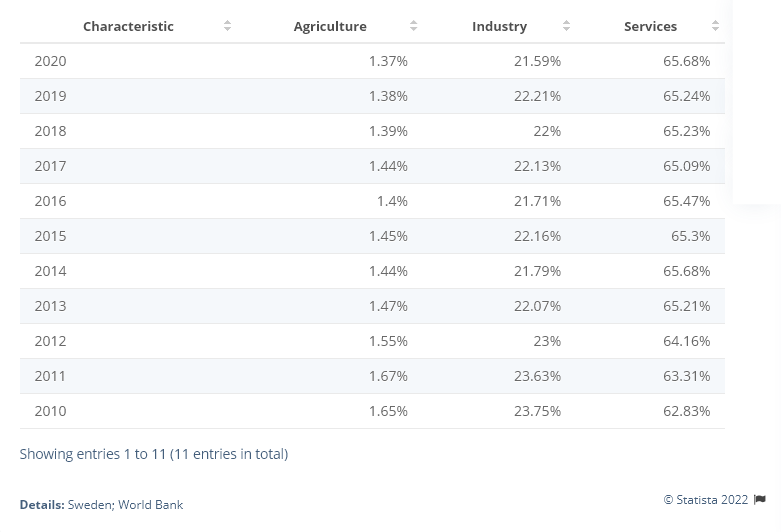
The balance of trade
Sweden has exported more than it imports consistently since 1981, and since then the balance of trade surplus has been in the range of 0% to 6.8% of GDP.
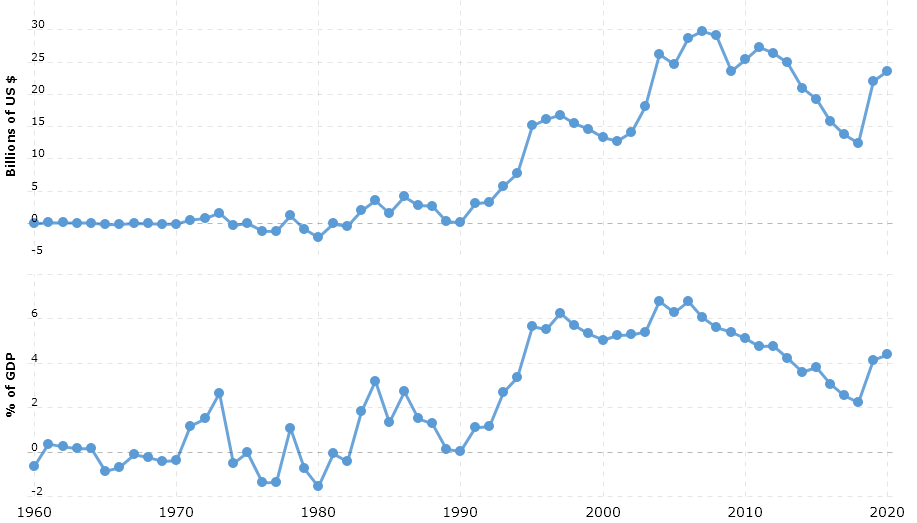
Exports by sector
The chart below shows how diverse the Swedish economy is, and illustrates the importance of products to the trade surplus, which surprised me as the economy is so services based.
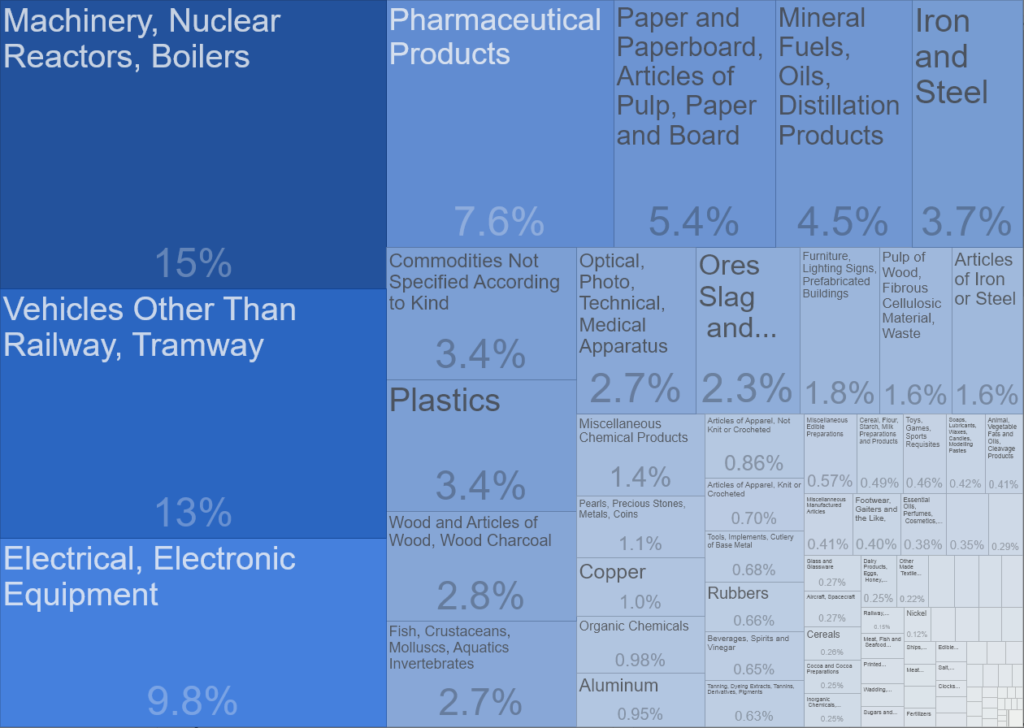
Wealth and income inequality
The most widely used measure of income distribution is the Gini index. It condenses several data points into a single number from 0 (perfect equality) to 1 (perfect inequality), although it is sometimes expressed as a number between 0 and 100.
The Gini value for Sweden for 2018 (the most recent year the World Bank website provides a value for) was 30, which is one of the more equal economies on earth, although since 1981 Sweden has been slowly trending towards greater inequality.
